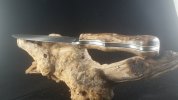- Joined
- Jul 31, 2015
- Messages
- 3,118
What scale thickness do you all usually start with on different knives (small hunters, chef's knives, fighters)? I always order 3/8" or so in everything, but I use liners as well most of the time. I'm thinking I just got in the habit of ordering 3/8" vs 1/4" since early on I could get into trouble and thicker stock would give me a margin of error to make corrections. Now I think i may just be wasting material. Thoughts?

